The New Motorola Moto X (2nd Gen) Review
by Joshua Ho on September 17, 2014 9:00 AM EST- Posted in
- Smartphones
- Motorola
- Android
- Mobile
Display
Without question, the display is one of the most important aspects of a smartphone. Unlike desktops and laptops, smartphones are primarily interacted with through their displays. Unfortunately, it’s hard to evaluate a display by eye as human vision is strongly dependent upon context. In order to control for this aspect, we turn to SpectraCal’s CalMAN 5 with a custom workflow in order to test smartphone displays. At any rate, let’s get into the data.
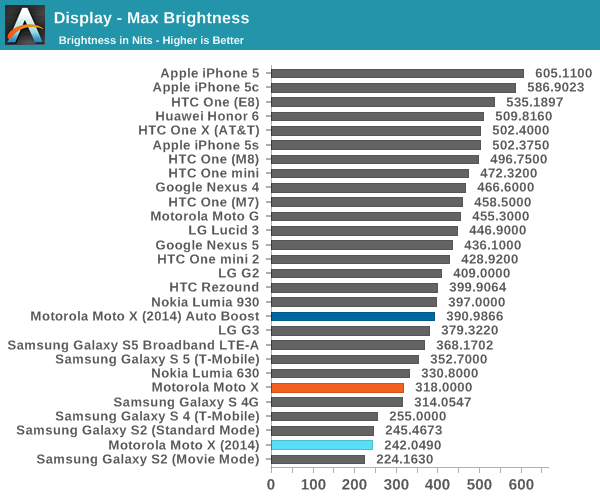
In the basics, the new Moto X is a bit on the low side. While AMOLED has traditionally struggled with luminance in situations such as the web browser and light-themed applications, Samsung’s Galaxy S5 and S5 LTE-A Broadband have shown that it’s possible to achieve levels of brightness approaching some of the brightest RGB-stripe LCDs. As the brightness of the Lumia 930 is about equal to the new Moto X, I suspect we're looking at the Galaxy S4/Note 3 generation of panels. This seems to be backed up by pictures of the subpixel layout seen below as the green subpixels seem to be noticeably larger when compared to the Galaxy S5's panel.
Contrast is still incredible, but I can still see the purple smearing effect that comes from unlit to lit pixels. I’m still unable to get a clear answer on why this is, but it’s likely that capacitance somewhere in the system is causing this issue in the form of RC delay. Whether this is a fixable issue is something I’m not aware of yet. The clear solution would be to set black to the lowest possible brightness a lit pixel can be, but this would make for worse contrast.

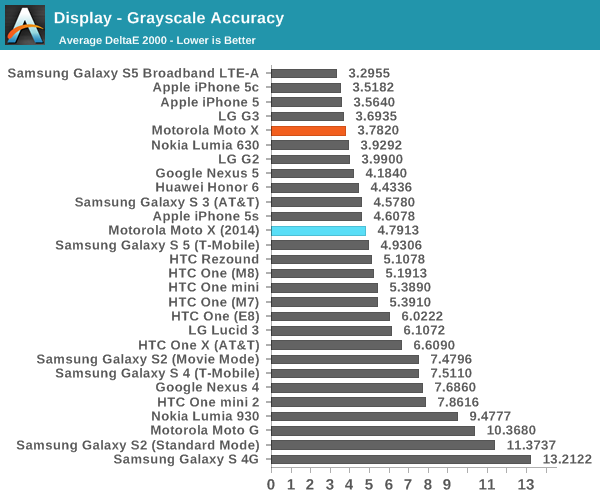
In grayscale, the new Moto X isn’t the best. We see that the display is just a bit too red, and that most of the luminance is coming from red and green. This makes sense from a power and display lifetime perspective though, as blue tends to have the least efficient emitter material in an AMOLED display. However, this translates to poor grayscale performance. The green tint tends to show itself in certain shades of grayscale as well.

In our saturation sweep, the new Moto X continues to be rather poor in its performance. While on Samsung phones it’s normal to see colors like this on the default display mode, there’s usually a mode that correctly constrains the display to sRGB which is the industry standard for displaying colors. There’s no such mode on the new Moto X, so the display significantly overshoots sRGB. This doesn’t bode well for the ColorChecker, which provides the most thorough look at color accuracy.
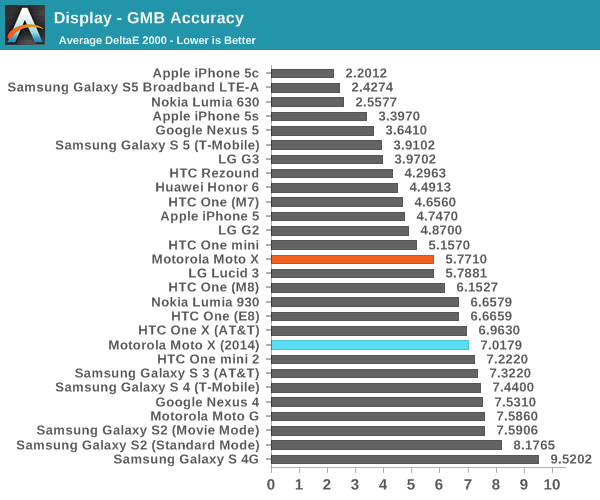
As predicted, the new Moto X does poorly in the ColorChecker. There’s really not much that the Moto X can accurately display in sRGB as just by pushing the gamut too far, even if there wasn’t saturation compression for some colors, the large gamut will cause distortion of all colors within the gamut triangle.
Unfortunately, it’s not clear where this lack of attention to color accuracy comes from. In discussions with Andrei it's clearly possible to calibrate the AMOLED panel from the GS4 quite accurately, and there's no real technical limitation for AMOLED to lack good calibration. However, judging by the relatively low peak brightness there are other issues as this could affect Motorola's performance in battery life tests. This seems to suggest that Motorola is unable to access the latest generation of AMOLED panels from Samsung Display.
This would be a rather startling thought, as it means that no matter what Motorola does to improve their implementation of Samsung’s AMOLED displays, they will always be behind the curve. If it becomes clear that Samsung’s AMOLED is the best display from a user-facing standpoint, every other OEM will face significant barriers in competition as they would be unable to access the latest generation AMOLED panels. The real solution here is for other display manufacturers such as LG, JDI, and AUO Optronics to catch up.
At any rate, the display of the new Moto X seems to be relatively poor compared to what we see in the Galaxy S5 LTE-A (and likely the Note 4), along with the iPhone 5s, Nexus 5, and One (M7). While it’s impossible to ignore the power advantage of AMOLED when implementing functions like Moto Display, the relatively low peak brightness and poor color accuracy are concerning.


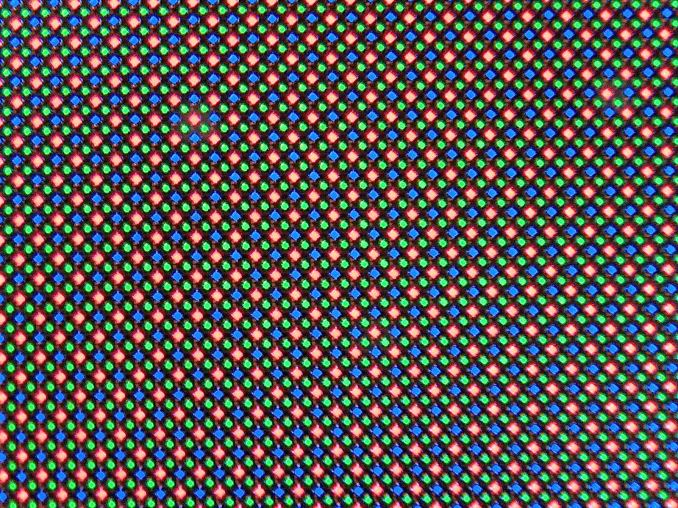

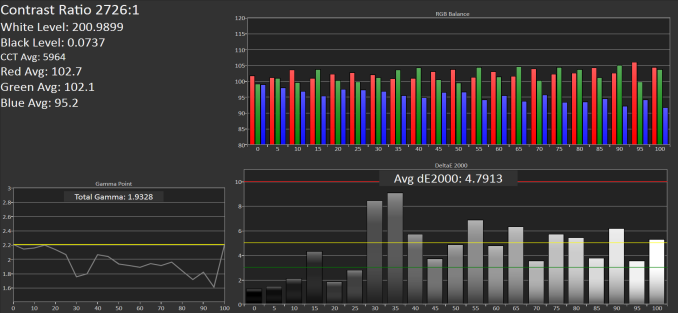

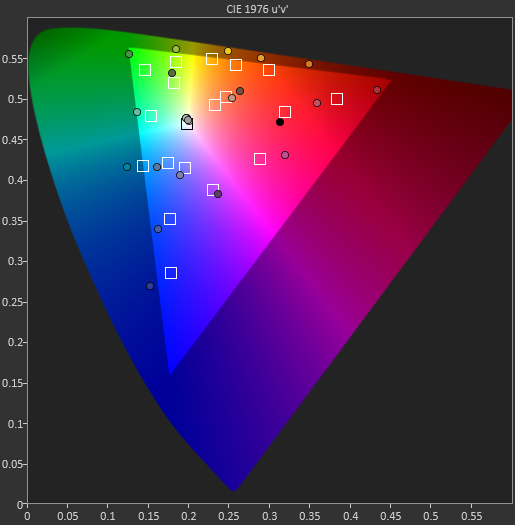








179 Comments
View All Comments
Dirty_Punk - Wednesday, September 17, 2014 - link
one thing that I can't understand, is why on Anandtech Iphone has such good battery life when ALL PEOPLE OF THE WORLD can demonstrate that iPhone battery life sucks... in all tests iPhone 5/5s are very near to LG G2 (at worst a 30% lower), that in real life have at least the double of the battery of iPhones....oscarnyc - Wednesday, September 17, 2014 - link
while I wouldn't go so far as to say that iPhone battery life 'sucks' I share your surprise at how well it does in AT's laboratory testing vs. real life experience, where, in my experience, it is little better than the current gen Moto X.aman.agx - Thursday, September 18, 2014 - link
It looks like the benchmarks are targetting select functions while shutting down all other background processes. So they are not reflective of your real life experience. So for example the contextual services on moto x might be eating up much less battery overall than something similar on an iphone. But if you shut down both of those, i phone battery will seem like a giant.melgross - Thursday, September 18, 2014 - link
That's not true. It doesn't suck. It's not as good as the best devices out there, but it's better than most. I tend to get a full day out of my 5, and I usually use it fairly often.There's a lot of anti Apple prejudice on this site from posters. It's really sad.
spikebike - Wednesday, September 17, 2014 - link
So motorola decided to give consumes the worst of both worlds. Thicker to allow for changing the backplate, but somehow not allowing changing the battery. To make matters worse they epoxied in a poor battery. So the result is a $500 disposable phone, with poor battery life, and you get to throw it away when the $15 battery dies.soccerballtux - Thursday, September 18, 2014 - link
honestly I feel like this review was pretty harsh. The camera isn't horrible, the AMOLED screen enables extensive black background screen on, the battery life is good enough, the phone has great software...so why so much hate?lostleaf - Wednesday, September 17, 2014 - link
Josh, can you comment on whether the display is viewable with polarized sunglasses in both portrait and landscape? Also does this phone have aptx?soccerballtux - Thursday, September 18, 2014 - link
good call, I've noticed this on my phones lately. What's up with that?Impulses - Monday, September 22, 2014 - link
It's basically a result of how polarization works, grab a cheap camera lens polarizer and play with it a little. I think phones usually prioritize portrait use, which generally makes sense, but sucks for looking at navigation (in landscape) with polarized sunglasses.Alex J. - Wednesday, September 17, 2014 - link
Thank you for yet another detailed review and for saving me money and time. As a previous owner of first-gen Moto X it's pretty disappointing to see that new Moto X is barely better in some aspects, and in some it is actually a regression. Most importantly, it still has horrible battery life and mediocre camera. As much as I love "Active Display" I'm afraid I will have to look at other flagships, with better battery life and better cameras.